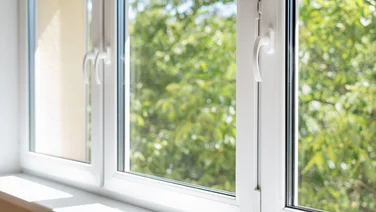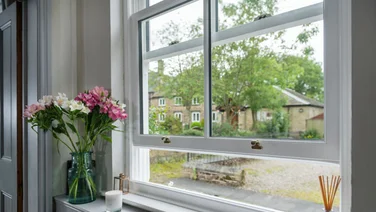- Moisture and condensation around windows makes them vulnerable to mould
- Any mould type can be a risk to health and households
- There are DIY solutions to remove mould from windows and stop it coming back
Finding mould is a headache for renters, landlords and homeowners, and it can be challenging to remove if not treated effectively.
Mould is recognisable by its musty smell and fuzzy green, white or black appearance, and it can cause structural and interior damage to your home. It can also create health issues, too.
This article dives into the best ways to prevent mould on your windows, including proper ventilation, smart cleaning and double glazing. Want to act extra fast? Use our easy-to-use quote tool today to find the best double-glazing offer for your home.

Why do windows get mouldy?
Approximately, 912,000 UK homes have mould, which is around 3.8% of all homes in the UK.
Mould grows through tiny spores that are invisible to the naked eye. It grows indoors when these spores settle in places with excess moisture, like your window sill, but can quickly spread across your home and require pricey repairs.
However, the main things that increase mould risk on windows are leaks from rotten or old window frames, ventilation systems failing to circulate humid air, and dampness rising from basements or ground floors.
Mould is often found on kitchen and bathroom windows because their moist air leads to increased condensation.
If you want to know how much new windows might set you back, look at our double glazing cost calculator.
How to remove mould from your windows
Before getting rid of mould, it’s important to ventilate the space by opening windows and doors and to protect your hands, nose and eyes by putting on rubber gloves, a mask and goggles.
Household items like washing up liquid and white vinegar can remove mould on windows.
If using washing up liquid, first mix it in a bucket with water. Dip a clean rag into the soapy water and firmly wipe the mould from the surface. Rinse the rag and repeat. If the mould is tough, scrub it with a coarse brush. Use a second dry cloth to wipe the area until clear and dry then dispose of the rags.
If using white vinegar, fill a small spray bottle or dip part of a wet cloth in vinegar, thoroughly spray or apply it to the mould, then leave it for one hour. Scrub or wipe the mould with warm water and a brush or clean rag. Wipe with warm water then leave to dry.

Should you remove window mould yourself?
Only remove window mould yourself if the area on or around the windows is less than one-meter squared.
Call a professional cleaning company if the area is any larger or if the mould is caused by sewage or contaminated water, rather than condensation.
How to prevent mould forming on your windows
Simply washing mould away won’t stop it from returning. It will return if you remove the fuzzy stuff but don’t eliminate the cause.
Once you’ve tackled the mould on your windows, use prevention techniques to keep it at bay forever.
Clean your windows on a regular basis
Regular (ideally weekly) cleaning of windows, sills, tracks, panes, and hinges will remove build-ups of dust and moisture and effectively keep mould at bay.
You can use small brushes, vacuum cleaners, and cloths to clean smaller surfaces or dislodge bacteria in tight corners.
It’s also useful to lubricate a window’s mechanical parts, like the hinges, to stop moisture from accumulating.
Even if you purchase specifically designed cleaners with anti-fungal agents, regular cleaning is a simple and cheap way to prevent mould on your windows. You will have to clean frequently and continuously for this solution to be effective.
Ensure maximum ventilation in your home
Use extractor fans and/or open windows when cooking (and when using the bathroom) to remove steam and humidity.
Wall and ceiling extractor fans typically cost around £60-£70 and use relatively little power to run, with a bathroom fan using between 5-36 watts depending on the type.
You should also regularly air out stuffy spaces like wardrobes and cupboards.
An alternative to having windows open in colder months is to buy a trickle vent, which is a background ventilator that can be integrated into window frames to let air flow out. They are inexpensive and straightforward to install.
Fix old or broken windows
Generally speaking, old or damaged window frames and seals are less effective at insulating your home against outside moisture and condensation. You should repair and replace these when you see signs of wear and tear or leakage.
The cost of replacing one window averages between £200 and £600. But well-maintained windows last between 20-50 years, so it’s an investment that will save you time and money in the long run.
Replacing single-pane windows with double or triple glazing is a smart way to keep condensation and mould at bay. The average cost of a double-glazed window is £1,200, making it seem expensive to purchase and install. However, it saves you an average of £195 per year on energy bills.
Act fast to control household damp
When water enters your home through floods, spills, leaking pipes or roofs, open windows, or faulty machines, quickly clean and dry all water-damaged carpets, furnishings and building materials, otherwise they become a prime place for mould to grow.
Get any household plumbing problems fixed fast, like burst pipes or blocked rain gutters.
These repairs are already necessary home improvements so if you’re properly looking after your home, the cost of these mould-prevention solutions are built-in. The key is to act quickly and be meticulous about cleaning and drying.
If you’d like to find out more about home improvement grants, read our dedicated guide.
Are wooden windows more likely to get mouldy?
Wood is a material that holds onto moisture, making it more likely to attract mould than windows or seals made from things like metal or uPVC.
However, when it comes to mould, no materials are safe. If you have wooden window frames and don’t want to replace them, they will require extra cleaning, painting, and sealing to keep mould away.
Does mould pose any health risks?
Mould and related problems like damp and excess cold produce allergens, irritants and sometimes toxic substances that pose health risks including asthma and poor mental health. You should limit contact with it regardless of mould type or how much there is.
Mould causes greater health risks to older people and those with asthma, eczema or respiratory difficulties and can be life-threatening in rare cases.
Is it safe to touch window mould?
Touching mould doesn’t cause severe risks to most people, but you should still avoid touching it and wash your hands immediately and thoroughly if you do.
Don’t touch mould on windows without rubber gloves if you know you’re allergic to it or have a cut, as mould spores can get inside the skin and cause infection.
Summary
- Mould isn’t going to destroy your home overnight, but the risks it poses to health and households make it more than an eyesore
- The best way to get rid of it on your windows is to stop it growing in the first place. Stop mould in its tracks by taking time to clean, ventilate, look after your windows and show damp the back door
- Regularly clean and dust your window frames, sills, tracks, panes, and hinges
- Ventilate your house with windows and extractors fans and whenever moisture enters your home, clean and dry it fast
- If left untreated, mould on windows can cause major harm to your home’s interior and structure and pose health risks from mild allergic reactions to more severe infections







